This journal is brought to you by…
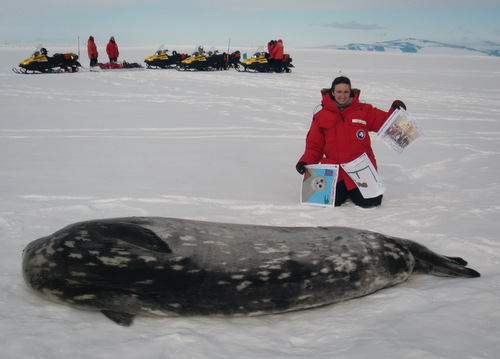
- Ms. Stephanie Porter’s 2nd, 3rd, 4th, and 5th graders at Lake Cormorant Elementary
- Ms. Karen Davis’s 5th grade class at Eastwood Elementary
- Mrs. Barsh’s 4th grade class at Oak Elementary
Do things in your world ever make you feel small?
Hanging out with the Weddell seals in Antarctica sure makes me feel small!
Just look at how big this seal is!
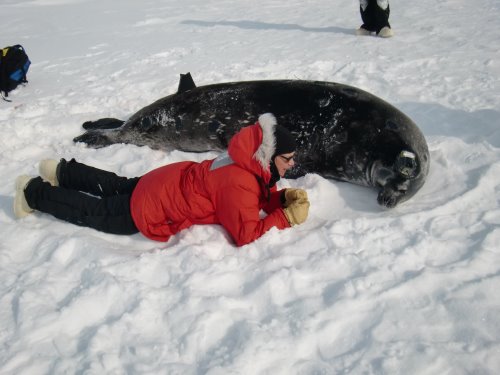
When I snuggled up next to this seal to take a photo, I realized just how small I was compared to the Weddell seal. What is one thing that makes the Weddell seal so much bigger than you or I? Any guesses?
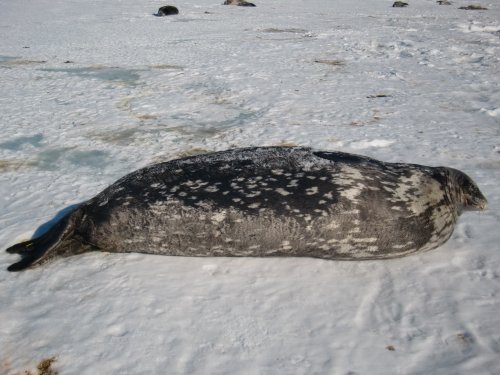
If you said blubber, you are correct.
Blubber is a special layer of fat. And with these Antarctic seals the phrase ‘bigger is better’ rings true!
Why do you think it is good for a Weddell Seal to have so much blubber?
Weddell seal’s weight
A little math never hurt anybody! Get out your calculators so we can compare ourselves to the Weddell seal.
Kids typically weigh somewhere between 50 – 150 pounds, depending on their age.
A Weddell seal usually weighs anywhere from 500 – 1,150 pounds!
Let’s say you weigh 100 pounds and a seal weighs 1000 pounds.

That seal would weigh 10 times as much as you! But how much of that is blubber?
Blubber makes up about 20 – 40% of the Weddell seal’s body. Seals generally have a lot more body fat than us! Can you hypothesize a reason the Weddell seal might have so much more fat?
Weddell seal shape up
While I was out looking for seals, I noticed these seal shapes in the snow.
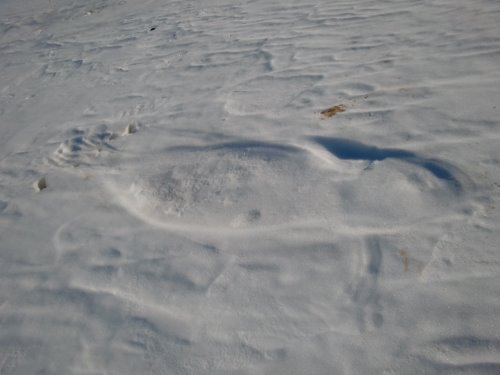
Does this looks like the outline of a seal? It should, because a seal was just resting here and left its imprint on the ice. Do you know how or why the ice melted? The seal’s body heat did that! And, how do you think the seal keeps so warm? Blubber! Blubber is an internal insulator; protecting their bodies from the cold and helping seals maintain their internal body temperature around 100° F. That’s pretty close to our body temperature, which averages around 98.6° F.
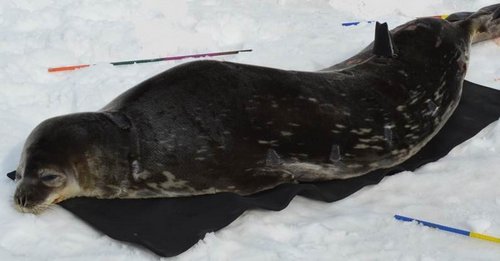
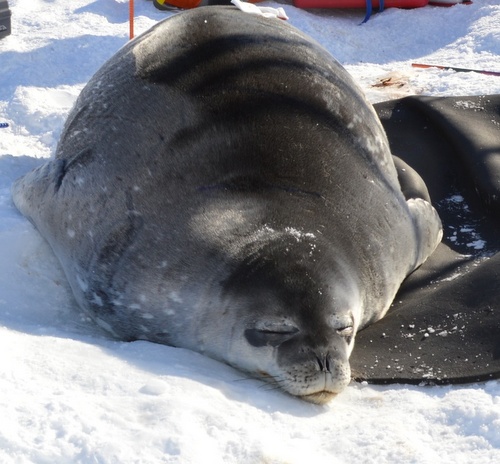
Why are some seals smaller than others?
In the Antarctic summer, seals are mating, pupping, and molting. Do you think seals have more blubber or less blubber during this time of year? Well, some of the seals we examine in the summer are nice and fat, but others are much smaller. The skinnier seals we’ve worked with are moms that have been feeding their pups. These moms lose about 30% of their body mass while they produce the milk to feed their growing pups, essentially transferring their blubber to the pups. While nursing, moms also spend less time foraging for food. After they finish nursing, the new moms will have to go on several foraging trips to build up that blubber layer again. Surprisingly, these new moms can gain up to one kilogram per day and can gain about 212 pounds in only two months!
The fatter seals are usually the skip breeders. They haven’t pupped, so they haven’t had to use their blubber reserve. Weddell seals that have lots of energy stored, like skip breeders during the summer, can have 2 inches of blubber under their skin. That thick layer can add up to 240 kilograms or 528 pounds of pure blubber!
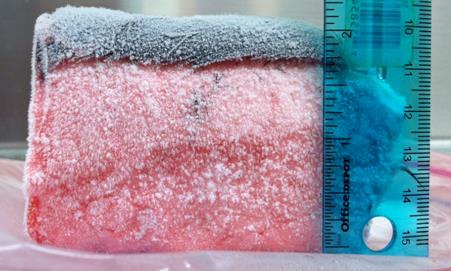
What’s blubber good for?
It’s nice to keep warm, but do you think blubber might have another purpose? Blubber is a form of fat. Seals breakdown this fat when they are doing activities like molting, pupping and mating. What do all these activities have in common? They require lots of energy! Blubber is a good way to store lots of fat that the seal can break down for ENERGY. Females, especially, use a lot of energy during the pupping season to care for their pups. Most of the energy they use goes to producing their calorie-rich milk which is made of 54% fat! Mom seals get all that fat they put in their milk from their blubber.
Pups are not born with much blubber. They have to quickly make their own, using fats from the milk that they get from their mom. The moms lose about 100 kilograms or 220 pounds of their own blubber while nursing their pups. That’s about 5 pounds of blubber per day. Wow!
Blubber purpose
Blubber is really neat stuff and serves two main purposes:
* It keeps the seal warm.
* It serves as a great way to store energy in the form of fat.
Blubber samples
Our research team is very interested in blubber, and we’ve been taking a lot of blubber samples!
What else do you think we can learn from the blubber?
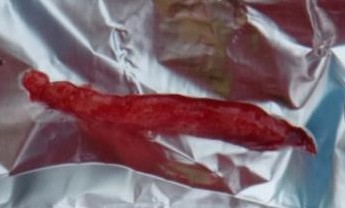
Have you ever heard the expression ‘you are what you eat?’ That expression holds true for Weddell seals, too. The Weddell’s blubber is made up of the fats that they eat. By analyzing their blubber, we can learn more about what the seals are eating. One of the big questions our research team is asking is which fish do Weddell seals eat more: Antarctic cod or Antarctic silverfish? These two fish differ in the fats they have, and so seals eating more of one species should have different fats in their blubber. Hopefully, these blubber samples can give us some clues!
Blubber thickness
Not only are we taking blubber samples, but we are also measuring blubber thickness. We measure the blubber thickness using an ultrasound machine.
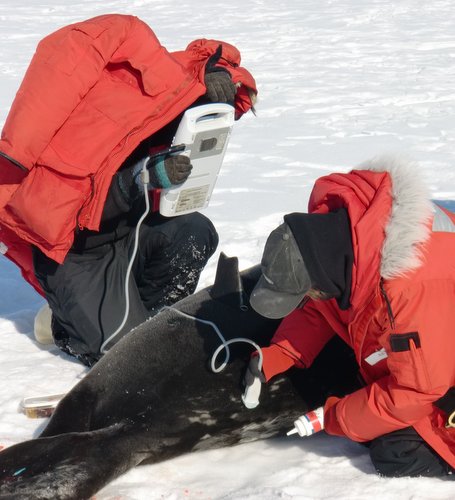
When we put the ultrasound probe against the fur of the seal, the ultrasound machine shows us the skin layer (below, right) and the fascia, which is the part where the blubber layer and the muscle layer meet.

By measuring the distance from the skin to that layer, we can figure out how deep the blubber is (red dotted line and arrow). The team will then compare the blubber measurements gather in the November/December season to the January/February season to see if or how they have changed.
But there is one thing about blubber that doesn’t seem to add up: why are some Weddell seals skipping their breeding cycle? These seals are nice and fat, so it is not a lack of energy!
We are hoping to get to the bottom of some of these questions during this field season. But, as is usual with science, sometimes those answers can lead to more questions. But that is what makes scientific research so exciting!


Comments